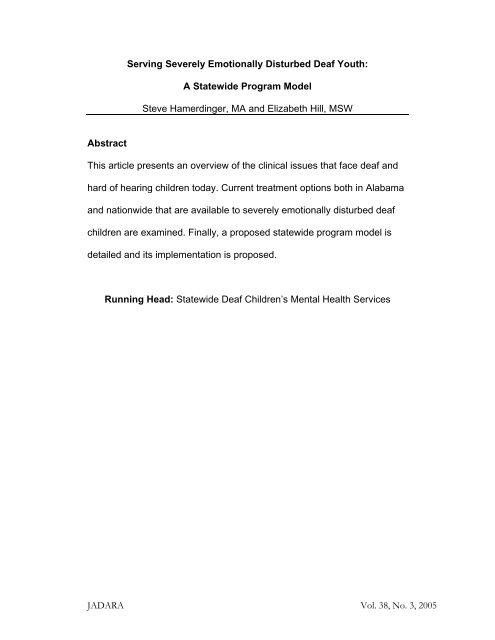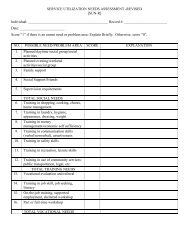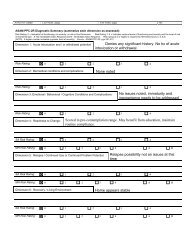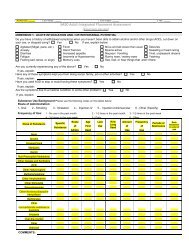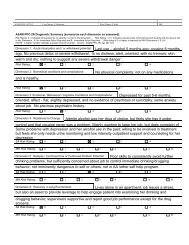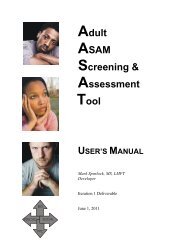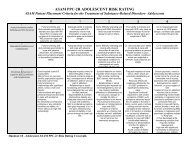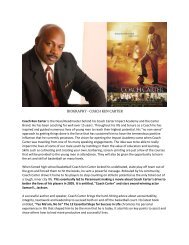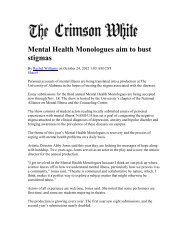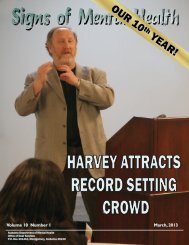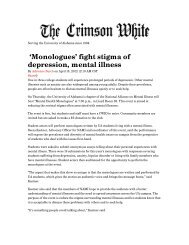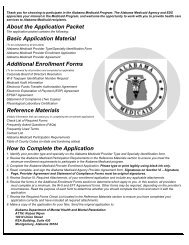Serving Severely Emotionally Disturbed Deaf Youth - Alabama ...
Serving Severely Emotionally Disturbed Deaf Youth - Alabama ...
Serving Severely Emotionally Disturbed Deaf Youth - Alabama ...
You also want an ePaper? Increase the reach of your titles
YUMPU automatically turns print PDFs into web optimized ePapers that Google loves.
Statewide <strong>Deaf</strong> Children’s Services Page 1<strong>Serving</strong> <strong>Severely</strong> <strong>Emotionally</strong> <strong>Disturbed</strong> <strong>Deaf</strong> <strong>Youth</strong>:A Statewide Program ModelSteve Hamerdinger and Elizabeth HillIntroductionThe importance of child and adolescent mental health in the generalpopulation has come to the public’s attention at a large cost. In the wakeof the Columbine massacre and other similar school shootings, it hasincreasingly become apparent to lawmakers and the public at large thatthe mental health needs of children and adolescents requires immediateattention. Approximately, one in five children in the United States has amental disorder. Five to nine percent of children ages 9-17 are affected bya serious emotional disturbance (SED) that causes severe functionalimpairment. Anxiety disorders, mood disorders, and disruptive disordersare the most common mental disorders among children (US Departmentof Health and Human Services, 1999). In fact, the Substance Abuse andMental Health Services Administration (SAMHSA) contended in a 2000report that it is time for child and adolescent mental health to be a majorpolicy concern. Among children aged 6-17 with mental disorders, 79% ofthem do not receive mental health care (Katoaka, Zhang & Wells, 2002).As a result, SAMSHA recommended the advent of a nationwide StateChildren’s Health Insurance Program.
Statewide <strong>Deaf</strong> Children’s Services Page 2The mental health crisis faced by deaf and hard of hearing children andadolescents is no less critical. (For purposes of this article, the authors willroutinely use the word “deaf” to mean both deaf and hard of hearingpopulations unless indicated otherwise.) While we have not yetexperienced a killing spree at a school for the deaf or at a public school bya deaf adolescent, it would be naïve to assume that there is any less needfor deaf children to have appropriate mental health services. A review ofthe literature confirms that deaf children are more at risk of developingpersonality, emotional, and behavioral disorders than the generalpopulation. This consensus is not limited to the United States. Severalstudies confirm that a greater prevalence of emotional and behavioraldisorders among deaf children seems to be an international phenomenon(van Eldik, Treffers, Veerman, and Verhulst, 2004; Mathos & Broussard,2005; Hindley, 1999).Clinical IssuesIt has long been debated whether deafness, per se, is a risk factor foremotional and behavioral disorders. Those who are strong advocates ofthe cultural view of deafness may bristle at the idea that people withhearing loss are more susceptible to mental illness. In a sense, they areright. Not hearing is often biologically irrelevant to mental status.However, deaf children have challenges that the larger hearing population
Statewide <strong>Deaf</strong> Children’s Services Page 3do not normally experience. Additionally, many people with hearing losscontract it through congenital syndrome which many also haveneuropsychological implications. So, while the biological hearing loss maynot lead to higher risk for mental illness, the psycho-social impact of thehearing loss creates other risk factors that most certainly do raise the risk.Early childhood hearing loss creates barriers to interfamilialcommunication, which in turn contribute to developmental deficits. Thesedeficits have been treated in detail in the literature and need not beaddressed here. It is sufficient for the purposes of this discussion to notethat these deficits have significant impact on how deaf children experiencethe world and how they adjust to it.Early childhood hearing loss also changes how they react to abnormalstimuli. The rank order of diagnostic syndromes of deaf children isdifferent than hearing children. Hearing children show a rank orderpattern of mood disorders followed by behavioral issues and thenpsychoses. <strong>Deaf</strong> children, on the other hand, are shown to morefrequently present with mood disorders, then psychoses, followed bybehavioral issues (Willis & Vernon, 2002). Some of the more commondiagnoses seen in deaf children are attention deficit hyperactivity disorder(ADHD), conduct disorder, oppositional defiant disorder, depression andanxiety (Hindley, 1999; Leigh & Anthony, 1999.)
Statewide <strong>Deaf</strong> Children’s Services Page 6be less responsive and more disruptive than their hearing siblings(Marschark, 1993). Inadequate explanations foster the deaf child’s inabilityto relate cause and effect, solve problems, and make thoughtful decisionsabout his or her own behavior. Coping mechanisms force the deaf childeither to take control of the environment or to be controlled by it. Althoughthe deaf children seen for therapy are of varied socioeconomicbackgrounds and have had different environmental advantages anddisadvantages, their common characteristic is a tendency to meet basicemotional needs in antisocial, rigid, or dependent ways. Thus, the typesof emotional and behavioral difficulties typically displayed by deaf childrenand adolescents appear to be outgrowths of the unique circumstancespresent during a particular period of development and not expressions ofpsychopathology as is commonly assumed by clinicians without training inthe psychosocial aspects of deafness. These assumptions are based ona lack of awareness or minimization of the unique biopsychosocialsequelae, which accompany deafness (Sarti, 1993).Indeed, Kennedy (1989) suggests that the consequences of deafnessoften mirror those associated with abuse (p.160). Sexual abuse andmolestation puts children and adolescents at a higher risk of developingemotional and behavioral disorders. Sexual abuse leaves children with thefeeling of being “different” or “damaged.” It forever colors the way the childviews the world and the relationships around them.
Statewide <strong>Deaf</strong> Children’s Services Page 7The statistics are truly alarming. <strong>Deaf</strong> children are 2-3 times more likely tobe sexually abused than their hearing peers (Kvam, 2004). Over 49% ofdeaf juvenile sex offenders have themselves been sexually abused (Willis& Vernon, 2002). In addition, over 85% of deaf adolescents in residentialtreatment centers have a confirmed or very strong suspicion of beingsexually abused in the past (Willis & Vernon, 2002).<strong>Deaf</strong> children are, then often traumatized, first by the lack ofcommunication and familial support, then by excessive physicalintervention that sometimes becomes outright physical abuse, and then bypredators who see then as easy prey. This first author recalls, early in hiscareer, treating a five-year deaf girl who was, at the time, pre-lingual. Sheexhibited behaviors what were sexually precocious and overtlyprovocative. Through the use of play therapy, it was revealed that thisyoung girl was being regularly sexually abused, up to and includingintercourse, by the mother’s live-in boyfriend. When arrested, theperpetrator remarked that he did it because he did not think the girl couldreport what he was doing.All these things, taken together, mean that the deaf child who is in need ofmental health treatment presents a complex mix of presenting problemsand symptomology that defy the application of traditional approaches by
Statewide <strong>Deaf</strong> Children’s Services Page 8clinicians who are not trained in deafness. “Treatment” which replicatesthe traumatizing experiences children have in their homes and schools arenot therapeutic.Determining the course of treatment is another area where deaf childrenare often slighted. For clinicians untrained in deafness and unable tocommunicate with deaf children, accurate assessment becomes extremelyproblematic. Clinicians must be aware that some instruments used tomeasure cognitive abilities have not been validated for use in the deafpopulation. Personality tests, which are normative for hearing Americanpeople, are frequently misinterpreted when used with deaf people.Diagnostic criteria need to be adjusted to account for differences duecompensation for hearing loss. For example, many behaviors that arenormal for deaf children, such as looking around the room forcommunication purposes, might be considered symptoms of ADHD inhearing children (Morgan & Vernon, 1994). Failure to take into accountthis phenomenological evidence of a qualitative difference in copingmechanisms can lead to over-diagnosis of ADHD in the deaf populationwith concomitant side effects from unnecessary drug treatment, andinappropriate school placements. Moreover, these inappropriatediagnoses remain in the child’s records with significant subsequent impactin how the child is viewed by educators and other clinicians.
Statewide <strong>Deaf</strong> Children’s Services Page 9Results of such assessments may be skewed due to variations incommunication abilities and cultural differences (Hindley, 1999). PoorEnglish skills are often equated with poor language skills, even amongchildren with exceptional fluency in American Sign Language.Additionally, deaf children with cognitive disabilities are likely to haveimpaired language use making assessment even more difficult.It is our contention that these differences argue for treatment that istailored specifically for deaf children. Unfortunately, such specializedprogramming is not available to most children who need it. Very fewplaces in the country have a true continuum of care, in which there is asystemic approach to tailoring clinical services to the level of need whilemaintaining cultural and linguistic appropriateness. Even more rare is forsuch a continuum to be coordinated on a statewide basis.Current Treatment Options - NationwideSome children are fortunate enough to either live near or have theresources to be referred to a specialized program. At the time of thiswriting, there are only a handful of specialized residential treatmentcenters for deaf children in the United States. By specialized we mean thatthese programs are noted for attempting to provide culturally affirmativemental health care. These programs provide, at a minimum, a core staff of
Statewide <strong>Deaf</strong> Children’s Services Page 10clinicians fluent in American Sign Language and treatment that is gearedto deaf children specifically. (A thorough treatment of culturally affirmativecare can be found in Glickman & Harvey, 1996).It is acknowledged that other programs may claim to have a “deafprogram” in their facility. For some programs, this may mean providinginterpreting services. Some facilities may have a member of the staff whoknows sign language. Other facilities simply house deaf children and call ita deaf program, with no attempt to modify treatment for the deaf child.The quantity and quality of these services vary widely, but none of themcan be called a program specifically for deaf children.Willis and Vernon (2002) define a residential treatment center (RTC) as aspecialized 24-hour facility that provides psychological, educational,social, recreational, psychiatric, and medical therapeutic services to youthwith severe emotional disturbances. Children requiring residentialtreatment care often come with a long list of emotional and behavioraldisorders which often include destructive and/or self-injurious behaviors.For deaf children, severe mental health problems are compounded byspecial communication needs and the likelihood of additional disabilities(Mason & Braxton, 2004).
Statewide <strong>Deaf</strong> Children’s Services Page 11In almost all cases, deaf children who end up in an RTC do so with ahistory of inappropriate and inadequate interventions that did not take intoaccount the specialized needs of visual communication and the nuancesof <strong>Deaf</strong> culture (Willis & Vernon, 2002). <strong>Deaf</strong> children often arrive at RTCswith an extreme feeling of powerlessness which may cause them to lashout at staff or draw staff into conflicts. The powerlessness derives from thesense that the adults in their lives would not communicate with them, andperhaps even viewed their deafness as a medical problem – one to besolved – rather than as a social problem requiring accommodation (Mason& Braxton, 2004). The adults in their lives may even resent their deafnessfurther exacerbating the mental health problems that the children face.Providing effective treatment for children who have such a challengingclinical presentation is a lengthy and complicated process that requiresattending to not just the child, but also the entire social systemsurrounding the child. In other words, treatment requires a continuum ofcare.A true continuum of culturally affirmative care for deaf children means thatservices are available in a variety of settings and are customizable to meetthe specific clinical needs of the child. Ideally, there should be a range ofservices form in-patient to outpatient services, available in the home andin the school. It also means that such a program would have strong tieswith schools serving deaf students. Regrettably, this is rarely the case.
Statewide <strong>Deaf</strong> Children’s Services Page 12For this article, seven RTCs where examined. Four of them have sometype of relationship with a state school for the deaf (Children's SeashoreHouse in eastern Pennsylvania, Buckeye Ranch in Ohio, Pressley Ridgein western Pennsylvania, and Desert Hills in New Mexico). The level ofthe relationship varies from program to program.To illustrate the variance of how programs operate, on one hand there isthe PRIDE Program, run by Pressley Ridge in collaboration with theWestern Pennsylvania School for the <strong>Deaf</strong>. Educational services areprovided on the campus in a school setting which is co-facilitated by stafffrom Pressley Ridge and WPSD. Group homes located off campus, but invery close proximity, are run by Pressley Ridge. Students move along acontinuum of levels of support depending on how they are coping andtheir ability to maintain. A student can be served entirely by PressleyRidge, partly mainstreamed into either the regular WPSD classrooms ordorms, fully mainstreamed into the classrooms or the dorms or somecombination thereof. Additionally, some students reside in therapeuticfoster homes rather the dorms or group homes. This continuum allows fora great deal of individualization of treatment.By contrast, the Desert Hills program in Albuquerque is embedded in alarger program for hearing children. All services are provided in residence
Statewide <strong>Deaf</strong> Children’s Services Page 13at the facility, although the staff has close ties with the New Mexico Schoolfor the <strong>Deaf</strong>. The facility provides consultation and assistance whenchildren transition back to school.The National <strong>Deaf</strong> Academy and the Tampa Bay Academy, which arelocated in Florida, and the Walden School, which is located inMassachusetts, are not associated with a school for the deaf. Instead theyhave their own charter school that provides education to residents yearround.There are several advantages for a program to be associated with aschool for the deaf. In addition to making it more likely that treatment willbe individualized to meet the specific needs of a given child, such colocationalso lends an important boost to staff recruitment efforts. Asstated before in this article, staff must also be fluent in American SignLanguage in order to provide culturally competent care. When a programuses hearing staff who are not fluent in American Sign Language, there isa risk of replicating the trauma of deficient communication in the home andin the school. Thus, the very place that is supposed to treating trauma ismerely adding to it.Often recruitment becomes a major challenge. There are simply morevacancies then there are people to fill them. When an RTC is affiliated
Statewide <strong>Deaf</strong> Children’s Services Page 14with a school for the deaf, the program is more readily able to attract highquality deaf professionals and paraprofessionals (Vreeland & Tourangeau,2003). <strong>Deaf</strong> professionals and paraprofessionals are much more likely tobe fluent users, if not native users, of American Sign Language. Thus,they are more likely to help facilitate the creation of an environment wheredeaf children will be able to communicate effectively.Additionally, a vibrant deaf community provides a built-in support systemfor the RTC staff. This is critical because those who are working with deafchildren in an RTC setting must be prepared to provide care for childrenwho most likely will have multiple disabilities, arrive “sicker” and be inneed of intensive treatment. Staff working in these programs are atnotorious risk for burnout (Mason & Braxton, 2004). Social supports andactivities outside work are an important part of any self-care plan.Co-location is not only helpful in the prevention of burnout, but also, thepresence of quality deaf professionals has important therapeutic benefits.These deaf adults can serve as role models for children who may neverhave had a deaf adult to look up to their whole lives. <strong>Deaf</strong> professionalsand paraprofessionals can introduce deaf children to the <strong>Deaf</strong> community.By learning about <strong>Deaf</strong> Culture, deaf children are allowed to explore a newidentity, one that they may have been unaware of at home.
Statewide <strong>Deaf</strong> Children’s Services Page 15In addition, by being affiliated on some level with a school for the deaf, theresidents of the RTC can gradually mainstream back into the school forthe deaf when they are ready to do so. Depending on their progress, theymay also be allowed to participate in social and athletic events at theschool as well. This is a powerful tool in the treatment of the deaf child.Current Treatment Options in <strong>Alabama</strong>According to the Gallaudet Research Institute at least 2 per 1,000 babiesare born with a severe to profound hearing loss. In <strong>Alabama</strong>, thistranslates to some 20,212 children between the ages of 2 and 18 whohave some degree of hearing loss that will affect their lives in some way. Itis estimated that 8.6% of a given population will need mental health careat some point in their lifetime. Using this estimate, approximately 1,738children will need our services.In a survey done of the community mental health centers (CMHCs) in<strong>Alabama</strong>, the authors found 141 deaf and hard of hearing children andadolescents were served over the past twenty-four months. An additional23 deaf and hard of hearing children and adolescents were under the careof the Department of Human Resources (DHR). All of these children areconsidered high-risk and high maintenance.
Statewide <strong>Deaf</strong> Children’s Services Page 16They are also extremely expensive. To illustrate, an example from thelead author’s experience is instructive. During one notable six monthperiod, the Missouri Department of Mental Health had two deaf teenageindividuals admitted into a state-run children's inpatient facility. One youthconsumed $14,000 worth of interpreting services during a two weektimeframe. This child was then released back into the same environmenthe came from, without significant modification of conditions that led to hishospitalization. The other deaf teenage boy utilized $59,000 of interpreterservices during his stay at that same facility (Hamerdinger, 2002).At the time of this writing, there are several adolescents from <strong>Alabama</strong> atthe National <strong>Deaf</strong> Academy (NDA) in Florida. To be sure, NDA is avaluable resource for the most severe cases, but some of theseadolescents could be better served through a culturally and linguisticallyappropriate community program. But because no such community optionexists for a deaf adolescent, the state is spending millions of dollars everyyear to keep these adolescents in that facility. The cost also putspressure on the social service system to bring them back to <strong>Alabama</strong>without having appropriate services in place.Even when the children are clinically ready to transition back home, thestate faces the challenge of how to provide services for them. All toofrequently what happens is the “revolving door” syndrome where the child
Statewide <strong>Deaf</strong> Children’s Services Page 17improves under treatment provided by a culturally and linguisticallyappropriate program, comes home and is referred to services that are notso appropriate. The child then decompensates because the system ofcare cannot respond in an affirmative manner and has to be readmitted toNDA or a similar program elsewhere.The problem with RTCs is that they are used for children who may be“problem” kids for schools, but clinically are not severe enough for thistype of placement. The Surgeon General’s report on mental health (1999)stated that too many children are inappropriately placed in the mostrestrictive RTCs simply because of the lack of community-based services.This is especially true with deaf children.As it now stands, there are three main treatment options: the <strong>Alabama</strong>School for the <strong>Deaf</strong> at the <strong>Alabama</strong> Institute for the <strong>Deaf</strong> and Blind,Community Mental Health Programs, and incarceration in the statejuvenile justice system. The latter option, while regrettably not infrequent,is not treatment at all.The <strong>Alabama</strong> School for the <strong>Deaf</strong> (ASD) currently has a number ofstudents who are severely emotionally disturbed and who also may havesecondary disabilities. ASD has mental health professionals who do asmuch as possible to help these students. However, their resources andability to help are limited. The mental health staff is limited in their ability to
Statewide <strong>Deaf</strong> Children’s Services Page 18provide family interventions, for example. They also have to be mindful ofthe implications for the school when a student becomes a danger tothemselves or other students which means alternative placement has tobe sought.On the other hand, in <strong>Alabama</strong>, many deaf children, outside of ASD,receive services from their local community mental health centers(CMHCs.) The authors have found repeatedly staff members at CMHCsand DHR are not prepared to work with deaf children with emotional andbehavioral disorders. Too often these clinicians and caseworkers areunfamiliar with deafness and its psychosocial implications. They are notaware that the treatment process needs to be modified to fit the deaf child.There are special nuances to watch out for. For example, somemedications in high doses cause visual side effects which can affect thedeaf child’s ability to understand another person’s signing (Hindley, 1999).CMHCs and staff members with little experience with deafness may notfully understand the implications of using an interpreter. For them, treatinga deaf child simply means contracting with the local interpreter referralagency. Clinicians may not understand that the very presence of aninterpreter completely alters the dynamics of the treatment. Having a thirdperson in the room changes the landscape of transference andcountertransference and alliances (Hamerdinger & Karlin, 2003).
Statewide <strong>Deaf</strong> Children’s Services Page 19Proposed Continuum of Care for <strong>Deaf</strong> ChildrenThe authors of this article are employed by the Office of <strong>Deaf</strong> Services(ODS) under the <strong>Alabama</strong> Department of Mental Health and MentalRetardation. ODS was established in 2002 as a result of the Baileyconsent decree. The primary mandate of ODS is to provide services todeaf and hard of hearing consumers with mental illness who range in agefrom 18-64. ODS is also responsible for educating the public on standardsfor providing culturally affirmative mental health services to this population.While technically an adult program, ODS is often called to consult in casesinvolving deaf children. Thus, the glaring gap in services for deaf childrenis increasingly highlighted with high profile and difficult to serve children.The need for a continuum of services for emotionally disturbed deaf andhard of hearing children and adolescents becomes distressingly moreapparent with each new case that is referred. This need has led to thedevelopment of a program model now under consideration for adoption in<strong>Alabama</strong>.This program model requires coordination of fragments of services alreadyin existence or being developed. At the present time, a number of stateagencies have been involved in attempting to serve deaf children with
Statewide <strong>Deaf</strong> Children’s Services Page 20psychiatric challenges. These agencies include the Department of HumanServices, the Division of Vocational Rehabilitation, the State Departmentof Education, and the Division of <strong>Youth</strong> Services, as well as severaldivisions of the Department of Mental Health and Mental Retardation.That some kind systemic approach to serving deaf children is desperatelyneeded is not disputed by the agencies. In fact, <strong>Alabama</strong> has set up aspecial task force for children with special needs that works across all theagencies and brings resources from each to the table. Thus the task forceis able to plan programming for the most challenging children. They havenot been able to effectively serve deaf children because a system of caredoes not exist for this population.Implementing a system of care is best done by instituting statewidecoordination by a person who is an expert in the mental health needs ofdeaf children and by developing some specific new programming. This<strong>Deaf</strong> Children’s Mental Health Services Coordinator should be highlytrained in working with deaf children with psychiatric problems.Newprogramming should include a network of specialized therapeutic fosterhomes and a component of intensive residential care for the few childrenwho cannot maintain stability in therapeutic foster homes.Ideally, the state residential school for the deaf would be accessed foreducational components as they are trained to meet deaf or hard of
Statewide <strong>Deaf</strong> Children’s Services Page 21hearing children cultural and linguistic needs. Crisis intervention would beprovided by a special case manager, backed up by an acute crisisresponse system. Arrangements must be made with a nearby acute carefacilities for crisis intervention and stabilization on an as-needed basis.Considerable training of staff at the acute care facility will be necessary inorder to ensure that deaf children are not harmed by the placement.An intensive transition home consisting of 6-8 beds should be created forchildren who are too unstable either the dormitories at ASD or fortherapeutic homes, but need not be hospitalized. This home would bebased on the PRIDE model where a small group of children living withprimary care givers (teaching parents) supplemented by additional supportstaff. The goal for the transition home program would be to assist thechildren in preparing for placement in the therapeutic foster homes.This program assumes all staff must be fluent in American Sign Languageand knowledgeable of <strong>Deaf</strong> Culture or this program will be ineffective andfail to meet the child’s needs. The intensive treatment home program willoperate 12 months a year, for about 344 days. Staff should have aBachelor’s degree or at least 5 years of experience working with deafchildren with emotional or behavioral problems. Pre-service and continualin-service training will be required to keep their knowledge current.
Statewide <strong>Deaf</strong> Children’s Services Page 22Statewide coordination of services and support for the therapeutic fosterhomes would be the responsibility of the <strong>Deaf</strong> Children’s Mental HealthServices Coordinator. In addition to program development aspectsalready mentioned, this person would work with school districts and otherstate agencies to ensure proper referrals to the program. The <strong>Deaf</strong>Children’s Mental Health Services Coordinator will supervise the casemanagers, intensive treatment home director, and other necessarysupport stuff.Case managers hired should have at least a Bachelors Degree in a socialservices related field, and preferably a Masters. They will function asliaisons between the children’s home, school, and treatment planningteams. These case managers should be spread out statewide and aremost effective if they are mobile, thereby able to support children with lesssevere behavioral or emotional challenges in their local communities.A training specialist would provide development and training for projectstaff, provide psychoeducational training pertaining to mental healthissues, educational, and <strong>Deaf</strong> Culture issues to consumers, therapeuticfoster parents, teachers, biological parents and/or guardians.Several other support staff would need to be recruited. Interpreters mustbe hired to facilitate communication between deaf and hearing people
Statewide <strong>Deaf</strong> Children’s Services Page 23involved in each child’s treatment. They can also provide sign languagecourses to parents, teachers, and other interested individuals involvedwith the program. Other support staff include an administrative assistantneeded to manage the office needs and perform clerical, recordsmanagement, and receptionist duties.Certain clinical services may need to be contracted. These include:• PsychiatristUsing emerging <strong>Alabama</strong>’s Tele-Psychiatry Project, this person willbe responsible for day-to-day medication tracking of all childrenenrolled in the program (Hamerdinger, 2004). For the purposes ofthis proposed program, the staff psychiatrist assigned to the deafunit at Greil could conceivably be utilized.• Child PsychologistThe project will contract with one or two psychologists whospecialize in deaf children. These clinicians will also access theTele-Psychiatry Project for testing and therapy issues that need tobe addressed within the children, DTFH, and biological family andsiblings.The intensive treatment home would replicate the highly successfulPRIDE HOUSE program at Western Pennsylvania School for the <strong>Deaf</strong>.Staffing needs consist of Lead Teaching Parent(s) to supervise teaching
Statewide <strong>Deaf</strong> Children’s Services Page 24parents and behavioral aides. This person will be responsible for dailydelivery and management of treatment services. The Lead TeachingParent would report to the Statewide <strong>Deaf</strong> Children’s Coordinator.Four Teaching Parents who will have responsibility of working directly withthe children in the transition home will be needed. Overnight staffing doneby behavioral aides and backup staff will assist when Teaching Parentsare unable to work their shift.Ideally, the intensive treatment home would be on or near the campus ofthe state school. This, however, may be impractical for logistical and/orpolitical reasons. The home should have 5 bedrooms, 3-4 bathrooms,kitchen, dining room, recreational room, and living room. The home wouldneed to be renovated to meet <strong>Alabama</strong>’s Community Program Standardsfor facility certification and the ADA (Americans with Disabilities Act)regulations for equipment such as signal systems for phones, fire alarms,doorbells, etc. A van will need to be readily available for transportation forappointments, recreational activities, and so forth.As program participants become more stable and able to better cope,reintegration into the general community becomes the goal. For somechildren, this will mean mainstreaming into the general campus life of thestate school. This process should be gradual and individualized. It would
Statewide <strong>Deaf</strong> Children’s Services Page 25require close cooperation between the school staff and the program staff.Program staff would need to be on-call to assist in intervening whenstudents are having difficulty. Regular therapy would be provided eitherby project clinicians or the school counselor as determined by thetreatment team.Other children will be more appropriately served in a therapeutic fosterhome. For a state the size of <strong>Alabama</strong>, up to ten therapeutic foster homeswould be needed to serve the deaf or hard of hearing children. Thesehomes would replicate the pilot project done in Missouri in the late 1990’s(Hamerdinger & Murphy, 2000). Foster parents must be able tocommunicate effectively in American Sign Language. There would beadditional therapeutic benefit if the foster parents were deaf themselves,although this would not be an exclusionary criteria. Support for the fosterparents would be provided by the case managers and the project staff.Ultimately, the program would seek to assist the child’s family in providinga better environment. The focus would be providing in-home assistance inthe tradition of wrap-around in-home supports. These supports wouldinclude communication skills training, training in behavior managementtechniques
Statewide <strong>Deaf</strong> Children’s Services Page 26ConclusionA system of care that provides a true continuum of services is the goal ofevery mental health program in the nation. For deaf children, this meansa system that is designed to take into consideration their unique linguisticand clinical needs. Such a system must be implemented cohesively. Ithas to be coordinated from the state level and incorporate servicesalready provided by various stakeholder agencies such as family services,education and the state mental health authority.
Statewide <strong>Deaf</strong> Children’s Services Page 27Bat-Chava, Y., & Martin, D. (2002). Sibling relationships of deaf children:The impact of child and family characteristics. RehabilitationPsychology, 47 (1), 73-91.Center for Mental Health Services, Substance Abuse and Mental HealthServices Administration. (2000). Mental Health and SubstanceAbuse Services Under the State Children’s Health InsuranceProgram. Designing benefits and estimating costs (DHHSPublication No. [SMA] 01-3473). Rockville, MD.Gallaudet Research Institute. (2005). Can you tell me how many deafpeople there are in the United States? [Online]. Available:http://gri.gallaudet.edu/Demographics/deaf-US.phpGregory, S. (1995). <strong>Deaf</strong> children and their families. Cambridge:Cambridge University Press (re-issue of The deaf child and hisfamily, George Allen Unwin, 1976).Glickman, N., & Harvey, M. (1996). Culturally Affirmative Psychotherapywith <strong>Deaf</strong> Persons. Mahwah, NJ: Lawrence Erlbaum Associates,Publishers.Hamerdinger, S.H. (2002). <strong>Serving</strong> Missouri’s deaf children who havesevere emotional disorders. Unpublished manuscript.Hamerdinger, S.H. (2004) Videoconferencing changes face of mentalhealth services. Signs of Mental Health 1 (4), 3.
Statewide <strong>Deaf</strong> Children’s Services Page 28Hamerdinger, S.H., & Karlin, B. (2003). Therapy using interpreters:questions on the use of interpreters in therapeutic settings formonolingual therapists. JADARA 36 (3), 12 – 29.Hamerdinger, S.H., & Murphy, D. (2000). Using the deaf community as analternative treatment strategy: Developing deaf treatment fosterhomes. JADARA, 33 (2), 26-41.Katoaka, S.H., Zhang, L., & Wells, K.B. (2002). Unmet need for mentalhealth care among U.S. children: Variation by ethnicity andinsurance status. American Journal of Psychiatry, 159, 1548-1555.Kennedy, M. (1989, Spring). The abuse of deaf children. Child AbuseReview, 3-7.Kent, B.A. (2003). Identity issues for hard-of-hearing adolescents aged 11,13, and 15 in mainstream settings. Journal of <strong>Deaf</strong> Studies and<strong>Deaf</strong> Education, 8 (3), 315-324.Kvam, M.H. (2004). Sexual abuse of deaf children: A retrospectiveanalysis of the prevalence and characteristics of childhood sexualabuse among deaf adults in Norway. Child Abuse & Neglect, 28,241-251.Leigh, I.W., & Anthony, S. (1999). Parent bonding in clinically depresseddeaf and hard-of-hearing adults. Journal of <strong>Deaf</strong> Studies and <strong>Deaf</strong>Education, 4 (1), 28-36.Marschark, M. (1993). Psychological development of deaf children. NewYork: Oxford University Press.
Statewide <strong>Deaf</strong> Children’s Services Page 29Mason, A., Mason, M., & Braxton E.T. (2004). Creating and strengtheningthe therapeutic system for treatment settings serving deaf children.JADARA, 37 (2), 1-19.Mathos, K.K., & Broussard, E.R. (2005). Outlining the concerns of childrenwho have hearing loss and their families. Journal of the AmericanAcademy of Child and Adolescent Psychiatry, 44 (1), 96-100.Morgan, A., & Vernon, M. (1994). A guide to the diagnosis of learningdisability in deaf and hard of hearing children and adults. AmericanAnnals of the <strong>Deaf</strong> 139, 358-370.Roberts, C., & Hindley, P. (1999). Practitioner review: The assessmentand treatment of deaf children with psychiatric disorders. Journal ofChild Psychology and Psychiatry, 40 (2), 151-167.Sarti, D. M. (1993). Reaching the deaf child: A model for diversifiedintervention. Smith College Studies in Social Work, 63 (2), 187-198.Steinberg, A.G. (1997). <strong>Deaf</strong>ness. Handbook of Child and AdolescentPsychiatry, 3, 364-377.U.S. Department of Health and Human Services. (1999). Mental health: Areport of the surgeon general. Washington, DC: Author. Available:http://www.surgeongeneral.gov/library/mentalhealth.van Eldik, T., Treffers, P.D.A, Veerman, J.W., & Verhulst, F.C. (2004).Mental health problems of deaf dutch children as indicated byparents’ responses to the child behavior checklist. American Annalsof the <strong>Deaf</strong>, 148 (5), 390-396.
Statewide <strong>Deaf</strong> Children’s Services Page 30Vernon, M., & Miller, K.R. (2002). Issues in the sexual molestation of deafyouth. American Annals of the <strong>Deaf</strong>, 147 (5), 28-37.Vreeland, J., & Tourangeau, J. (2003). Culturally affirmative residentialtreatment services for deaf children with emotional and behavioraldisorders. In N.S. Glickman & S. Gulati (Eds.), Mental health careof deaf people: A culturally affirmative approach (pp. 239-260).Mahwah, NJ: Erlbaum.Willis, W.G., & Vernon, M. (2002). Residential psychiatric treatment ofemotionally disturbed deaf youth. American Annals of the <strong>Deaf</strong>, 147(1), 31-38.


